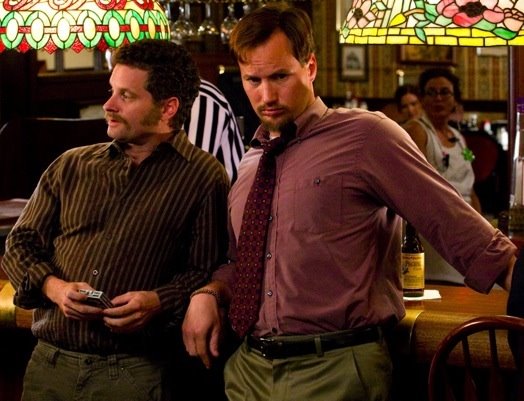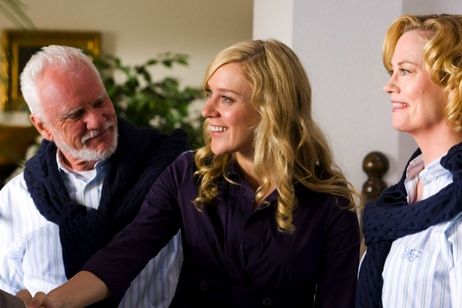By Robert Sims, Special to the MovieKit.com
 At the end of Little Children, Patrick Wilson helps Jackie Earle Haley after his convicted child molester castrates himself in a bid to stop him from falling into his old ways. In Barry Munday, it’s Wilson who suffers a similar fate when he loses his testicles. The difference is, Barry Munday plays Wilson’s severe injury for laughs.
At the end of Little Children, Patrick Wilson helps Jackie Earle Haley after his convicted child molester castrates himself in a bid to stop him from falling into his old ways. In Barry Munday, it’s Wilson who suffers a similar fate when he loses his testicles. The difference is, Barry Munday plays Wilson’s severe injury for laughs.
Director Chris D’Arienzo’s indie comedy, which received its world premiere at SXSW, follows the changes Wilson’s insufferable dickhead undergoes after his unfortunate accident. Chloe Sevigny and Judy Greer play the sisters — the former an admitted slut, the other a virgin — who help Wilson move forward with his life in comical fashion.
I spoke with Wilson, Sevigny, Greer and D’Arienzo following Barry Munday’s packed premiere about the comedy’s painful premise, the trust fostered on the set, and the cool cat that is Billy Dee William.
Step 1: Don’t get too attached to your manhood
Patrick Wilson: “It’s funny I’ve had a history of some kind of emasculation in movies. This was the first time it actually was quite literal. What I loved about it was you — once they established who he was — thought it was the most outlandish circumstance, but the coolest journey for a story essentially about this being about becoming a man, to have this completely stripped away, that was exciting.”
Step 2: Make your directorial debut with a story that speaks to you
Chris D’Arienzo: “The characters were really specific and human. They weren’t traditional movie romantic comedy characters. They were flawed and their flaws were like really naked. And I just really liked that. When I read it, there was a possibility there was a way to do this that was kind of in the spirit of comedies that I really love. Movies like Harold and Maude or The Graduate….”
Step 3: Assemble the coolest cast possible
D’Arienzo: “I never would have dreamed to have this cast. But when it actually became the process of casting, we just had a lot of fun with who is your dream person and start there. As far as like certain characters like Billy Dee [Williams’] character, Lonnie, and Jennifer for Chloe as Ginger’s sister, I felt like in those two instances I was like, Jennifer needs to be the coolest person in Ginger’s world just like Lonnie’s kind of the coolest person in Barry’s world. So I just kind of went for who I think are the coolest actors.”
Step 4: Then persuade Billy Dee Williams to play the coolest cat in the film
D’Arienzo: “We went to L’Ermitage [Bevery Hills Hotel to discuss the role]. Anytime I’m in that lobby…I only see rappers and NBA stars like all that time. And so hanging with Billy Dee was like hanging with the Pope. It was kind of fantastic. He doesn’t do a ton of movies now, but he’s such a fantastic actor and a wonderful guy and he was really sweet. And he was like, ‘So why did you think of me for this?’ And I said, ‘Well, I just think Lonnie needs to be the coolest guy in Barry’s universe, and I was trying to think who is the coolest guy in my universe. It’s Billy Dee’ And he just kind of looked at me and went, ‘And you’d be right.’ And we got really close actually, it was like really sweet. We would go have dinner all the time, it was just awesome. He’s a really, really wonderful guy.”
Step 5: Get in touch with your inner geek
Judy Greer: “Putting a character together from the outside in, it’s fast and easy. Once I’m not wearing makeup and I’m in like my clogs, which were my own clogs, and it was funny because on set, I actually remember, I forget who said it, ‘And then you have to wear those awful shoes.’ And I was like, ‘Those are mine.’”
Wilson: “Yeah, they’re really terrible. I would never wear these in my real life.”
Greer: “It was icing on the cake for Ginger. But it’s so easy, once you get those clothes on. And that’s true really for me, for all the characters, once I know what I’m wearing and what I look like, it starts to sort of come together. And then there’s walking stuff, and Ginger definitely doesn’t stand up very straight. I mean, those things. And then it all sort of comes together. And when she’s talking in the movie, when Ginger, when I talk about being ugly and what it feels like. When I was looking like that, I really felt that way. I felt angry at people who like, you know, going to Starbucks cut in front of me in line, or whatever, and I’m like, Really? I’m here, I’m a person that’s standing here.”
 Step 6: Take the risk and go for laughs
Step 6: Take the risk and go for laughs
Chloe Sevigny: “I think everybody involved and meeting Chris and talking about the film and what he wanted to do with it. And kind of his references to other films that he loved, the kind of movie that he wanted to make. I’ve never been in a comedy, a straight-up comedy before, so that of course attracted me to the project.”
Step 7: Take the risk and follow up your big-budget superhero saga with a small indie comedy
Wilson: “Until you’re like kind of super famous and can turn down all that stuff, I’m not in that situation. I’m lucky to have great support around me. And I love my agents. I think back to when I signed with them, nine years ago, it was always very creatively driven. It was not, ‘Look, let’s turn down this great role because I think you can get in this big budget movie.’ Because the reality is I’ve done some big-budget movies and they haven’t been as successful. But I never had one, ‘Oh, I don’t know if you should do this, let’s wait for something.’ Because that’s not me. And luckily they get that.””
Step 8: Watch the Watchmen weight
Wilson: “The first time I got the script, I was shooting Watchmen, so luckily it just sorta fit with this guy. We all know this type of guy — he’s still hanging onto the ’90s, when he thought he was cool when he hung out at the Bennigan’s after-dark bar. And you know, I also thought there was something incredibly cool about not being vain about it, and just actually the fact that you did get to see like a shower scene and a love scene and just have him still be doughy. So, I didn’t necessarily try to keep it on, but it wasn’t until after Barry Munday that I said, Alright, let me get back in shape. So it worked for this.”
Step 9: Trust your first-time directorGreer: “I’ve worked with lots of first-time directors, and he was so prepared. That was like what was really impressive to me. He had so much enthusiasm for the movie when I met with him. And he came to work with photographs and his shots for the day and he knew exactly what he wanted. Sometimes, I don’t know, directors aren’t really that prepared. You show up and you’re like, You’re getting this opportunity. Nobody gets to do this, and you won the lottery and you don’t know what you want to shoot today?”
Wilson: “The thing about film, too, you can come from such different backgrounds. Sometimes you’re a writer, sometimes you’ll work with a guy that’s done just a bunch of commercials or a guy that’s a DP, a choreographer, whatever it is. But at the end of the day, you really have to know visually what you want. It’s funny, and this is coming from the guy from the theater, but in a weird way, I don’t care if you give me these great acting notes, I want to know what you want to shoot because this is a director’s medium. This is not an actor’s; film is not an actor’s medium. He knew the style that he wanted. If you can hang on a scene, a comedic scene from one angle, for four minutes, if you can do that, you have to have supreme confidence in your script, in you, in your actors, in the situation, because you’re not telling people to laugh and then a quick cut to reaction. Now comedies have their place too, but for this style of comedy, it’s almost like a ’70s style of comedy, you have to trust the situation and luckily you’re given such a great base really for as quirky as it can be. This is a love story about two people who would never come together and how they worked around their very blatant, concrete differences and circumstances and really come together Chris, he just knew, because he’s just a humble guy and an enthusiastic guy, he’s like, ‘Actually, the way I want to shoot this, is like this.’ And just you gotta go with it. And it worked. And truthfully, a lot of times, when you only have a couple angles, producers, editors, everybody else when you get into the editing room, they all get scared, because it’s like, ‘Can we cut to something and put a sound cue in there and that’s gonna make people laugh?’ Just trust it. Trust it and let it sit.”
Step 9: Trust your cast to trust you
D’Arienzo: “It’s completely terrifying at times, but when you’re actually working — one of the things we wanted to do was do lots of masters and let scenes play out in one shot and you can only really do that if you have really great actors. So, once we were actually working and we were in this kind of structure and OK, we’re going to try this all out here in this one shot, then I was completely at ease because I didn’t have to worry. Everyone was just completely at the top of their game.”
Sevigny: “I have to say it was the calmest set I have ever been on. And one of the funniest. I mean, everybody was so relaxed. So mellow, and everybody got along. I was like, ‘What the hell is going on? Are we making a movie here? Shouldn’t there be tension? Shouldn’t people be screaming about getting the shot?’ We did really minimal takes and minimal set ups. It was really nice. It was really laid back.”

